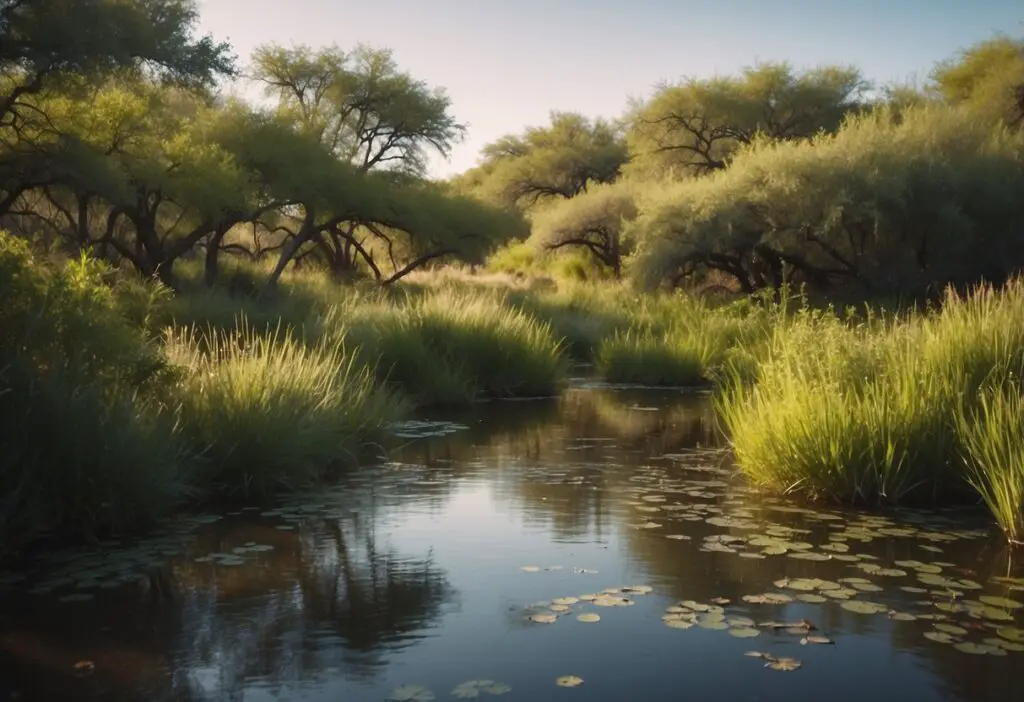Nestled in the heart of Phoenix, the Rio Salado Habitat Restoration Area is a remarkable example of transformation and conservation. Once a dump site, this area has been revitalized into a lush corridor teeming with wildlife. Visitors can explore diverse trails, spot over 200 species of birds, and enjoy the serene environment.

This 600-acre park now boasts marshlands, trees, and a vibrant riparian habitat along a five-mile stretch of the Salt River. The collaborative effort between the city, federal, and county agencies has turned this wasteland into a sanctuary for nature lovers. Walking through the trails, one can’t help but marvel at the thriving ecosystem created from what was once barren land.
Bird watchers, hikers, and volunteers find joy in contributing to and exploring this natural haven. Educational programs offer rich resources for learners of all ages, making Rio Salado a center for not just recreation but also learning and community involvement. For more information, explore the Parks and Recreation Rio Salado Habitat Restoration Area.
Key Takeaways
- The Rio Salado area was transformed from a dump into a vibrant habitat.
- Over 200 species of birds can be spotted in the area.
- Educational programs and trails offer learning and recreational opportunities.
Overview of Rio Salado Habitat Restoration Area

The Rio Salado Habitat Restoration Area is a significant natural space located just south of downtown Phoenix. It stretches along five miles of the Salt River and covers nearly 600 acres.
This area was transformed from a former dump site into a lush, thriving ecosystem. The project aimed to restore the native wetland and riparian habitats of the Salt River, which once flowed year-round through Phoenix.
Visitors will find a mix of paved and dirt trails, ideal for hiking, biking, and wildlife photography. The area is renowned among bird watchers, with more than 200 species of birds spotted.
The Rio Salado Habitat Restoration Area offers educational opportunities through tailored field trips. Park Rangers are available to guide groups, providing a hands-on experience to explore the riparian habitat. This makes it an excellent resource for schools and nature enthusiasts.
The restoration project was a collaborative effort involving the City of Phoenix, the U.S. Army Corps of Engineers, and other local organizations. This teamwork led to significant environmental improvements, making the area a valuable space for both wildlife and humans.
History and Vision

The Rio Salado Habitat Restoration Area represents a significant effort in environmental conservation and urban renewal. It transformed a former dump site into a thriving riparian habitat, highlighting specific conservation actions and funding mechanisms that made this possible.
Conservation Actions
The Rio Salado Habitat Restoration Project began in June 2000. It aimed to restore the natural riparian habitat along a five-mile stretch of the Salt River in Phoenix. This collaboration involved the City of Phoenix, the U.S. Army Corps of Engineers, and other local and federal organizations. They planted native vegetation like Cottonwood, Willow, and Mesquite.
Restoration efforts also included the removal of 1,185 tons of tires and other debris from the site, making it habitable for wildlife. The park now features paved and dirt trails, which provide access to wildlife enthusiasts and visitors. The restoration efforts attracted over 200 bird species and various mammals such as javelinas, coyotes, and muskrats.
Arizona Water Protection Fund
The project received a crucial financial boost from multiple partners, including the Arizona Water Protection Fund. This fund played a significant role by providing matching federal construction funding, authorized by congress in August 1999. The funding covered part of the $85 million needed for the project.
The Arizona Water Protection Fund specifically helped in creating sustainable water management practices in the area. Twenty-two storm drains were installed to funnel runoff from rain into the habitat, ensuring a consistent water supply. This comprehensive funding approach made the Rio Salado Habitat Restoration Area a model for urban environmental projects.
The project’s vision included promoting educational opportunities and enhancing biodiversity. Educators and park rangers now use the area to provide hands-on learning experiences for students and the community, making it a dynamic and educational urban oasis.
Ecology and Biodiversity

The Rio Salado Habitat Restoration Area boasts a rich ecosystem with diverse plant and animal life. It includes native wetland and riparian habitats, supports numerous species of birds, and is home to various wildlife.
Native Wetland
The native wetland within the Rio Salado Habitat Restoration Area is critical for sustaining biodiversity. It features a variety of aquatic plants like reeds and cattails, which contribute to water quality and provide habitat for fish and amphibians.
Wetlands are crucial for water filtration. They help manage floodwaters and support many species. This habitat attracts insects, providing food for fish and birds, integrating the wetland into the broader ecosystem.
Riparian Habitats
Riparian habitats at Rio Salado stretch along the Salt River. This corridor includes trees like cottonwoods and willows, which stabilize riverbanks and reduce erosion.
The riparian zone is crucial for wildlife. It offers shelter and nesting sites for birds and small mammals. It also supports a variety of plants that thrive in moist soils, enhancing biodiversity.
Species of Birds
Bird watchers have spotted over 200 bird species in the Rio Salado area. This includes species like the Great Blue Heron, American Kestrel, and Red-tailed Hawk.
Many birds rely on different habitats within the restoration area. Wetlands attract waterfowl, while riparian zones are favored by songbirds. Bird diversity indicates the health of the ecosystem, as birds are important pollinators and insect controllers.
Wildlife
The Rio Salado Habitat Restoration Area supports various wildlife. Common species include coyotes, rabbits, and lizards, which thrive in the diverse habitats available.
The area also supports fish species, especially in managed ponds. These species contribute to the ecological balance, serving as prey for birds and other animals. Overall, wildlife diversity reflects the success of habitat restoration efforts.
For more information about the Rio Salado Habitat Restoration Area, you can visit Parks and Recreation Rio Salado Habitat Restoration Area and The Rio Salado Habitat Restoration Area.
Recreational Activities
The Rio Salado Habitat Restoration Area offers a variety of recreational activities. Visitors can enjoy trails, bird walks, fishing, biking, and hiking, making it a popular destination for nature lovers and outdoor enthusiasts.
Trails
There are five miles of trails that wind through the Rio Salado Habitat Restoration Area. These trails are a mix of paved and dirt paths, catering to different preferences. Whether you prefer a smooth walk or a more rugged hike, the area has something for everyone.
Numerous trails with minimal elevation changes make the area accessible. The trails are well-marked and maintained, allowing for easy navigation through the diverse landscapes. These trails are perfect for casual walks, energetic jogs, or even guided tours by Park Rangers.
Bird Walks
The Rio Salado Habitat Restoration Area is a hotspot for bird watchers. Over 200 bird species have been spotted here, making it a prime location for bird watching. Ornithologists and wildlife photographers often visit to observe and capture images of the many bird species in their natural habitat.
Guided bird walks are available, providing educational opportunities. These walks are led by knowledgeable guides who can help visitors identify various bird species. Whether you’re a seasoned bird watcher or a novice, these bird walks are a wonderful way to enjoy the park’s avian life.
Fishing
Fishing at the Rio Salado Habitat Restoration Area offers a peaceful way to connect with nature. The restoration of the wetland and riparian habitats has brought back fish to the area. Anglers can enjoy a quiet day of fishing along the Salt River.
Designated fishing spots are available, providing safe and accessible locations to cast a line. Visitors are encouraged to observe all local fishing regulations to help maintain the health of the ecosystem. It’s a great activity for families, friends, or solo enthusiasts looking to enjoy a day by the water.
Biking
Biking is a popular activity at Rio Salado. The trails offer a mix of paved and dirt paths, accommodating both casual cyclists and those seeking a bit more adventure. The area’s smooth surfaces and minimal elevation changes make it an ideal spot for an enjoyable ride.
Bikers can take in the scenic views and lush landscapes as they ride through the area. There are designated bike trails that ensure safety for all visitors. Cyclists of all skill levels will find the trails accommodating and enjoyable.
Hiking
Hiking enthusiasts will find the Rio Salado Habitat Restoration Area to be an excellent destination. The variety of trails provides options for both easy walks and more challenging hikes. Hikers can explore the lush riparian corridor, taking in the sights and sounds of the restored habitat.
The well-maintained trails make hiking a safe and enjoyable activity. Trail maps are available to help hikers plan their routes. The area’s natural beauty and diverse wildlife make hiking here a rewarding experience for nature lovers.
Educational Programs and Resources

The Rio Salado Habitat Restoration Area offers a variety of educational programs and resources. These programs are designed to engage the community, guide bird watchers, and provide interpretive learning experiences.
Nina Mason Pulliam Rio Salado Audubon Center
The Nina Mason Pulliam Rio Salado Audubon Center is a key part of the Rio Salado Habitat Restoration Area. This nature center provides a hub for environmental education and community programs. It offers workshops and classes on ecology, conservation, and bird watching.
Families and school groups can explore interactive exhibits and participate in hands-on activities. The center also hosts special events and lectures from experts on topics related to local wildlife and habitats.
Guided Bird Walk
The Guided Bird Walk offers an opportunity to explore the habitat with experienced guides. These walks are typically scheduled in the early morning when bird activity is at its peak. Participants can see a variety of bird species, learn about their behaviors, and get tips on bird identification.
The walk is suitable for all ages and skill levels. Binoculars and field guides are often provided to enhance the experience. This activity is especially popular with bird watchers and photographers looking to capture the beauty of the area.
Interpretive Learning Center
The Interpretive Learning Center is another educational cornerstone. It features interactive displays and exhibits that explain the history and ecology of the Rio Salado Habitat. Visitors can learn about the restoration efforts that transformed a former dump site into a thriving riparian habitat.
Staffed by knowledgeable park rangers, the center offers guided tours and educational programs. These programs cover a variety of topics, from the importance of wetlands to local wildlife conservation. The center is an excellent resource for educators looking to bring their students on engaging field trips.
The Rio Salado Habitat Restoration Area’s educational resources play a crucial role in connecting the community with nature and teaching the importance of conservation.
Visitor Information

The Rio Salado Habitat Restoration Area offers a variety of amenities and activities for visitors, suitable for nature enthusiasts, families, and educators. The park is accessible all year round with free admission, making it a great destination for outdoor recreation.
Park Amenities
The Rio Salado Habitat Restoration Area is equipped with a range of facilities. It offers several hiking and biking trails that wind through the lush riparian habitat, providing excellent opportunities for birdwatching and wildlife photography. The trails are well-maintained and feature interpretive signs to enhance the educational experience.
Visitors can take advantage of free guided bird walks on the first and third Saturday of each month from 8 a.m. to 9 a.m. These walks are led by knowledgeable Park Rangers and begin at the Rio Salado Audubon Center. The center itself offers an interpretive learning experience with exhibits related to conservation and local wildlife.
There are picnic areas available for families and groups, complete with tables and shade structures. Additionally, the site includes restrooms and water fountains for convenience.
Open Hours and Admission
The Rio Salado Habitat Restoration Area is open year-round. Visitors can enjoy the park from dawn to 7 p.m. or dusk, whichever comes first. Entry to the park and all its events is free, making it an affordable option for a day out in nature.
The Rio Salado Audubon Center is the central hub for information and activities, and even when the center itself is closed, the surrounding trails remain open.
For those interested in organized activities, such as bird walks or educational programs, it’s best to check the Rio Salado website for schedules and details.
Community Involvement and Volunteerism
The Rio Salado Habitat Restoration Area thrives because of the strong community involvement. Volunteers contribute their time and skills, while various events and community programs foster engagement and education.
Volunteers
Volunteers are the backbone of the Rio Salado Habitat Restoration Area. They participate in activities such as planting native vegetation, removing invasive species, and maintaining trails to ensure the area stays healthy and accessible.
These individuals often receive training from park rangers, equipping them with the knowledge to care for the habitat. Volunteer opportunities are available for people of all ages. The efforts of these volunteers have made a significant impact, transforming the area into a thriving ecosystem.
Events
The Rio Salado Habitat hosts numerous events to engage the community. Bird-watching tours, clean-up days, and educational workshops are popular. These events provide hands-on experiences, allowing participants to learn about the local environment and wildlife.
Special events, such as Earth Day celebrations and seasonal festivals, attract large crowds. They offer a chance for people to come together and appreciate the natural beauty of the habitat. Events are often co-hosted with local organizations, enhancing the sense of community.
Community Programs
Community programs at the Rio Salado Habitat Restoration Area include educational initiatives and recreational activities. The Nina Mason Pulliam Rio Salado Audubon Center plays a significant role, offering free programs and events for all ages.
Programs focus on topics like bird conservation, plant identification, and ecological sustainability. They also include field trips for students, providing a hands-on learning environment. The new pollinator garden project is a notable initiative, promoting the conservation of bees and butterflies while involving community members in its upkeep, enhancing community engagement.
Conservation and Sustainability
The Rio Salado Habitat Restoration Area highlights the importance of environmental conservation and wetland sustainability. It showcases successful restoration efforts and ongoing wetland protection initiatives.
Restoration Efforts
The Rio Salado Habitat Restoration Project transformed a neglected area into a thriving ecosystem. Once a dried-up riverbed, the restoration turned it into a lush, riparian corridor.
The project was a collaborative effort involving the City of Phoenix, the U.S. Army Corps of Engineers, and the Maricopa County Flood Control District. Together, they cleaned up the area by removing 1,185 tons of tires and other debris. This massive effort allowed native plants and wildlife to return.
These restoration efforts helped re-establish habitats for over 200 species of birds and animals. The success of this project provides a model for similar restoration endeavors, showcasing the impact of dedicated conservation actions on urban environments.
Wetland Protection
Protecting the wetlands is essential to maintaining the health of the Rio Salado Habitat. Wetlands act as natural water filters and flood control systems, supporting biodiversity.
To ensure the conservation of these vital areas, ongoing maintenance and monitoring are crucial. The City of Phoenix works with organizations like the Audubon Society to manage and protect the wetlands. These efforts include creating spaces like the new pollinator garden, which supports bees, butterflies, and other pollinators.
Educational programs, often led by knowledgeable Park Rangers, also play a key role. They help the public understand the importance of wetland conservation and engage communities in protecting these natural resources. The continued success of these initiatives is key to sustaining the health and diversity of the Rio Salado Habitat.
Access and Facilities

The Rio Salado Habitat Restoration Area offers visitors a variety of ways to explore its natural beauty, all while providing convenient access and well-maintained facilities. Here, one can find multiple trailheads, suitable for different types of activities, and ample parking options.
Trailheads
Visitors can start their exploration from several trailheads. These include both paved trails and dirt trails, catering to different preferences. The area is known for its nature trails that wind through lush riparian habitats and scenic viewpoints.
The City of Phoenix has ensured that the trails are well-marked and maintained. Some trails are designed for walkers and cyclists, while others are specifically for equestrian use, ensuring that all visitors can find a trail that suits their needs. Park Rangers often provide maps and information at these trailheads.
Parking
There are ample parking facilities throughout the Rio Salado Habitat Restoration Area. Most trailheads have dedicated parking lots that are easy to locate and access.
Parking areas are situated at key entry points, such as the 7th Avenue Start Site, making it convenient for those coming from different parts of the city. The City of Phoenix has invested in creating these parking areas to support the increase in visitors and to ensure safety and convenience. During peak times, parking can fill up quickly, so arriving early is recommended.
Rules and Regulations

Visitors to the Rio Salado Habitat Restoration Area should be mindful of rules designed to protect both wildlife and fellow guests. These regulations ensure that the habitat remains a thriving ecosystem and an enjoyable space for all.
Wildlife Protection
Preserving the wildlife within Rio Salado is crucial. Visitors must not disturb animals or their habitats. This includes keeping a safe distance from all wildlife. Touching, feeding, or attempting to interact with any animals is prohibited. Doing so can cause stress to the animals and disrupt their natural behaviors.
Pets should be kept on a leash at all times. This helps prevent them from chasing or harming wildlife. It’s also imperative to stick to marked trails. Straying from designated paths can damage plants and disturb animal homes.
Fishing and hunting are strictly not allowed. These activities can negatively impact the ecosystem. Additionally, guests should avoid picking plants or collecting natural items like rocks or feathers.
Visitor Conduct
Maintaining a peaceful environment is essential for all guests. Loud noises and music are discouraged as they can disturb both wildlife and other visitors. Bringing food and beverages is allowed, but visitors must clean up after themselves. Littering harms the habitat and creates hazards for wildlife.
Bicycles are permitted on certain trails, but riders should yield to pedestrians. The speed limit for bicycles is set to ensure everyone’s safety. Skateboarding is not permitted within the area.
The City provides free admission, making it accessible for all. Still, proper conduct ensures everyone enjoys the space. It’s advised to follow any instructions from Park Rangers and read posted signage for up-to-date rules.
For more information on how to enjoy your visit responsibly, visit the Rio Salado Habitat Restoration Area.
Frequently Asked Questions

The Rio Salado Habitat Restoration Area is a site rich in amenities and wildlife, offering visitors a chance to both explore and contribute to conservation efforts.
What amenities are offered at the Rio Salado Habitat Restoration Area?
Visitors can enjoy paved and dirt trails along five miles of the Salt River, which provide smooth surfaces and minimal elevation changes. The area also features birdwatching spots and educational programs for all ages.
Are there any guided tours available for visitors at Rio Salado Habitat Restoration Area?
Yes, the Rio Salado Habitat Restoration Area offers guided hikes and birdwatching tours. These tours can answer basic questions and make the visit both educational and entertaining. It’s suggested to bring a hat, water, binoculars, and a bird field guide.
What types of wildlife can be seen in the Rio Salado Habitat Restoration Area?
The area is home to more than 200 species of birds. Visitors often spot various native wetland and riparian species. With its lush vegetation, the site is a valuable habitat for many local animals.
What are the operating hours of the Rio Salado Habitat Restoration Area?
While specific hours are often posted on the official website, it’s generally accessible from early morning until late evening. Always check ahead for seasonal variations or special events.
How can volunteers get involved with the conservation efforts at Rio Salado Habitat Restoration Area?
Volunteers are welcome to help with various conservation projects. To get involved, check the official website for more information on ongoing efforts and how to sign up.
Is there a trail map available for visitors to navigate the Rio Salado Habitat Restoration Area?
Yes, detailed trail maps are available, and they can be downloaded from the City of Phoenix site. These maps help visitors navigate and explore the various trails efficiently.






